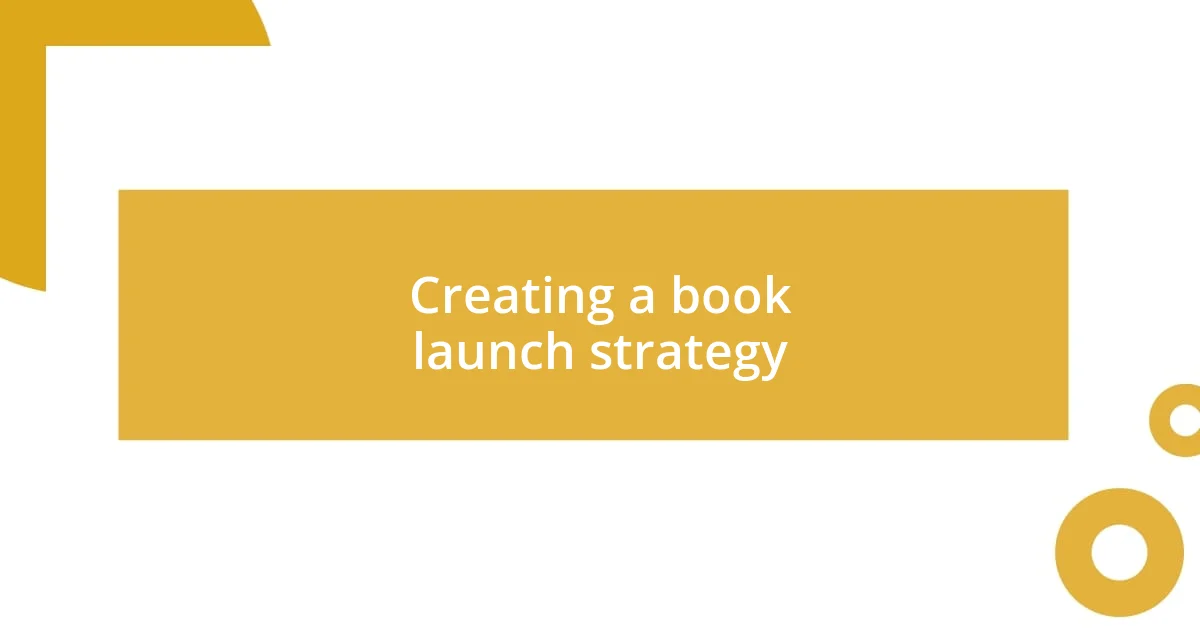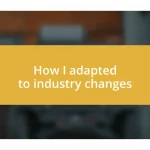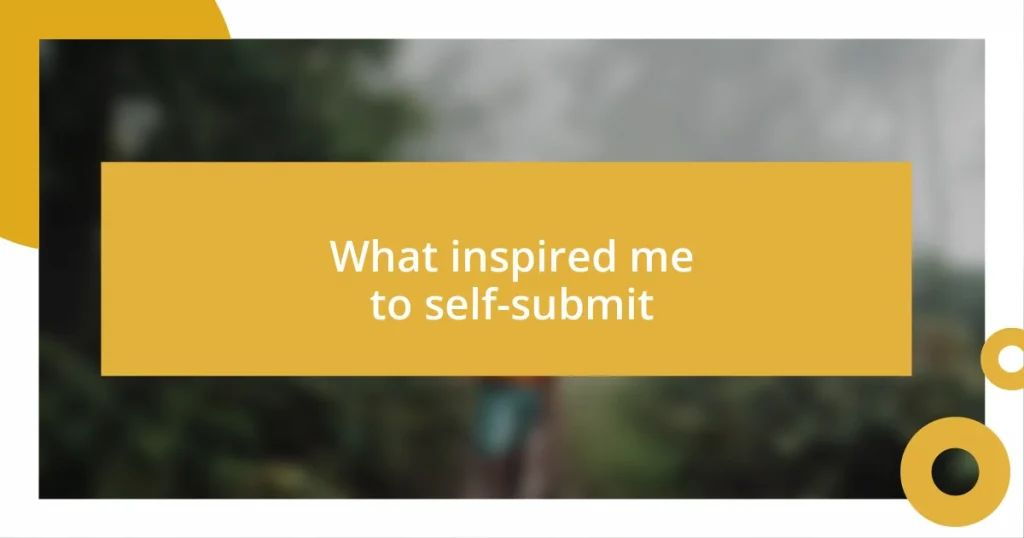Key takeaways:
- Understanding your target audience deeply enhances promotional strategies, enabling authentic connections through shared emotions and values.
- Building an author platform through social media, a personal website, and collaboration with other authors fosters community engagement and expands visibility.
- Utilizing email marketing effectively not only promotes content but also strengthens relationships with readers, creating a sense of belonging and excitement around the author’s work.

Understanding your target audience
Understanding your target audience is crucial for effective marketing. When I first started promoting my debut novel, I spent countless hours identifying who my readers were. What specific interests did they have? It amazed me how a little demographic research revealed trends and preferences that shaped my promotional strategies.
I remember scrolling through social media groups and forums where my potential readers hung out. It struck me how engaged they were, sharing their love for particular genres and themes. This interaction fueled my desire to connect with them, and I often found myself asking, “What will resonate with them?” By tailoring my messaging to address their needs, I was able to create a buzz that felt authentic and inviting.
It’s not just about knowing your audience’s age or location; it’s about understanding their feelings and values. I’ve learned that when I tapped into the emotions they experienced while reading—like nostalgia or excitement—I could build a deeper connection. How do you think your story aligns with the emotions of your audience? Perhaps reflecting on your own emotions during your writing process can help clarify this connection.

Building an author platform
Building an author platform is essential for creating a presence that resonates with your audience. When I started this journey, I focused on using social media not just to promote my book but to cultivate genuine relationships. I recall crafting posts that shared snippets of my writing process, which led to engaging conversations with aspiring authors and avid readers alike. This sense of community made my platform feel more like a shared space instead of just a promotional tool.
In addition to social media, having a personal website was a game changer for me. I remember feeling proud when I launched mine, featuring not only my book but also a blog where I could share insights into my creative process. This platform allowed me to explore themes related to my novel while also providing a place for readers to connect directly. As I started sharing my triumphs and struggles, my authenticity helped to build trust and encourage others to join me on my writing journey.
Finally, I realized the value of connecting with other authors. Participating in online workshops and local literary events helped me build rapport with fellow writers, which in turn expanded my visibility. I still remember the thrill of exchanging contacts with someone whose work I admired, leading to collaborative efforts down the line. This network became a vital part of my platform, enriching my experience and increasing my outreach potential.
| Platform Type | Description |
|---|---|
| Social Media | A place to share updates, engage directly with readers, and build a community. |
| Personal Website | An online hub for showcasing books, sharing blog posts, and connecting with readers. |
| Collaborative Efforts | Networking with other authors for joint events or projects, enhancing visibility. |

Utilizing social media effectively
Utilizing social media effectively has been a journey of exploration and strategy for me. I’ll never forget the first time I went live on Instagram to discuss my book; my heart raced, yet the connection with viewers was electrifying. Sharing those raw moments allowed me to engage directly with potential readers and feel their excitement as they asked questions and interacted with me in real-time.
- Create engaging content: Share behind-the-scenes looks at your writing process to make readers feel part of your journey.
- Use visuals: Eye-catching graphics or video snippets can attract attention and increase shareability.
- Engage actively: Respond to comments and messages to foster a sense of community and loyalty among your audience.
One of the best practices I found was using targeted hashtags for my genre. I remember spending an afternoon researching which tags were trending and realizing how significantly that changed the reach of my posts. Each time I saw new followers join after my posts, it ignited a sense of hope and motivation. It made me feel like I was building something meaningful, not just for myself, but for those who connected with my work.

Creating a book launch strategy
Creating a book launch strategy requires thoughtful planning and execution. When I mapped out my launch, I realized how important it was to set a clear timeline. I remember sitting down with my calendar and marking key dates, such as when to start promoting cover reveals and scheduling virtual events. This visual roadmap kept me focused and energized as I approached my launch day, making the whole experience feel less overwhelming.
I also discovered the power of collaboration during my launch. One memorable moment was when I teamed up with fellow authors for a joint book release event. The buzz created from our combined audiences was exhilarating. It made me wonder—how much more impactful can our efforts be when we lift each other up? By leveraging our networks, we reached readers who might not have discovered our books otherwise.
Finally, I found that engaging with my audience pre-launch created anticipation. When I teased exclusive excerpts and shared countdown posts, I noticed that readers were genuinely excited and eager to support my release. This made me reflect deeply: isn’t fostering excitement just as critical as the actual publication? It turns out, building that hype helped solidify a community around my work, and it’s a strategy I plan to use in future projects.

Generating buzz through pre-reviews
Generating buzz before a book’s release involves harnessing the power of pre-reviews effectively. I reached out to a handful of beta readers and influencers in the literary community and was thrilled when they agreed to read advanced copies. Their feedback during those early stages was invaluable, not just for the book’s content but for the excitement they generated through their enthusiasm on social media. I still remember one reader’s tweet where she wrote, “I couldn’t put this down! Can’t wait for everyone to read it!” Moments like that fill me with gratitude and remind me just how vital that buzz can be in creating anticipation.
I also experimented with creating buzz by organizing a pre-review blog tour. I was awe-inspired by how one dedicated blogger even created a themed post showcasing her favorite characters alongside artwork from the book. It’s truly remarkable how creative people can get when they are passionate about a story. Have you ever shared a snippet of your work, then watched it spread like wildfire? That’s what I experienced, and it really reinforced the idea that readers love feeling like they have a stake in the journey—like they’re part of the adventure even before it launches.
In addition to everything, I learned that consistently sharing these interactions and reactions built momentum. I often posted quotes from early reviews, sprinkled with my thoughts about their significance at the moment. When I saw readers resharing those quotes, I felt like I was witnessing the organic growth of a community around my work. Isn’t it comforting to know that excitement is contagious? Those pre-reviews didn’t just spotlight my book; they illuminated a vibrant connection with the readers that I hope will last long after the launch.

Engaging with local communities
Engaging with local communities turned out to be one of the most rewarding strategies in promoting my debut novel. I recall attending a local book club meeting, where I nervously presented my work. It felt surreal to see people order their copies on the spot after my reading. I vividly remember a young woman who expressed how one of my characters reminded her of her grandmother. Those connections grounded me, validating my journey as a writer.
I also discovered the power of local events, like farmers’ markets and library readings. One Saturday morning, I set up a small booth at the market with bookmarks and a copy of my book on display. The warm sunlight and friendly faces made it easy to strike up conversations. What surprised me was how many locals were genuinely curious and engaging. A retired teacher shared how her students loved writing stories, and it made me ponder—can storytelling ignite a love for literature in young minds? I believe it can.
Moreover, I took advantage of local social media groups dedicated to books and literature. I remember posting about my upcoming readings and welcoming feedback. This led to a vibrant discussion where members shared their thoughts on local authors and reading preferences. It was heartening to witness how the community rallied around shared interests. Isn’t it amazing how a simple post can create such lively engagement? These moments reinforced my belief that when authors connect with their local communities, the support is not just beneficial; it helps cultivate a shared love for stories and creativity.

Using email marketing for reach
I discovered early on that email marketing was a game-changer for my novel’s reach. After building a mailing list from my website visitors, I sent out newsletters to share insights about my writing process and provide exclusive content. The thrill I felt when I saw the open rates soar made me realize how engaged my readers were. Have you ever hit send on an email and felt a rush of anticipation? It’s electrifying, especially when you know you’re connecting directly with your audience.
Crafting those emails became an art form in itself. I’d often include personal stories—like the late nights I spent revising chapters—alongside sneak peeks of upcoming book promotions. One time, I shared an emotional anecdote about overcoming writer’s block, and the replies flooded in. Readers opened up about their own struggles and triumphs, creating a community where everyone felt they could share their journey. Isn’t it incredible how vulnerability can foster connection?
Additionally, I implemented a “reader spotlight” feature, showcasing feedback from my most dedicated fans. This not only made them feel appreciated but also encouraged others to engage. When I included a picture of a reader holding my book at a cafe, it generated a delightful response. People started sharing their own photos with my book, turning it into this lovely momentum. I realized then—email marketing isn’t just about selling; it’s about building relationships that resonate and create excitement around your work.















